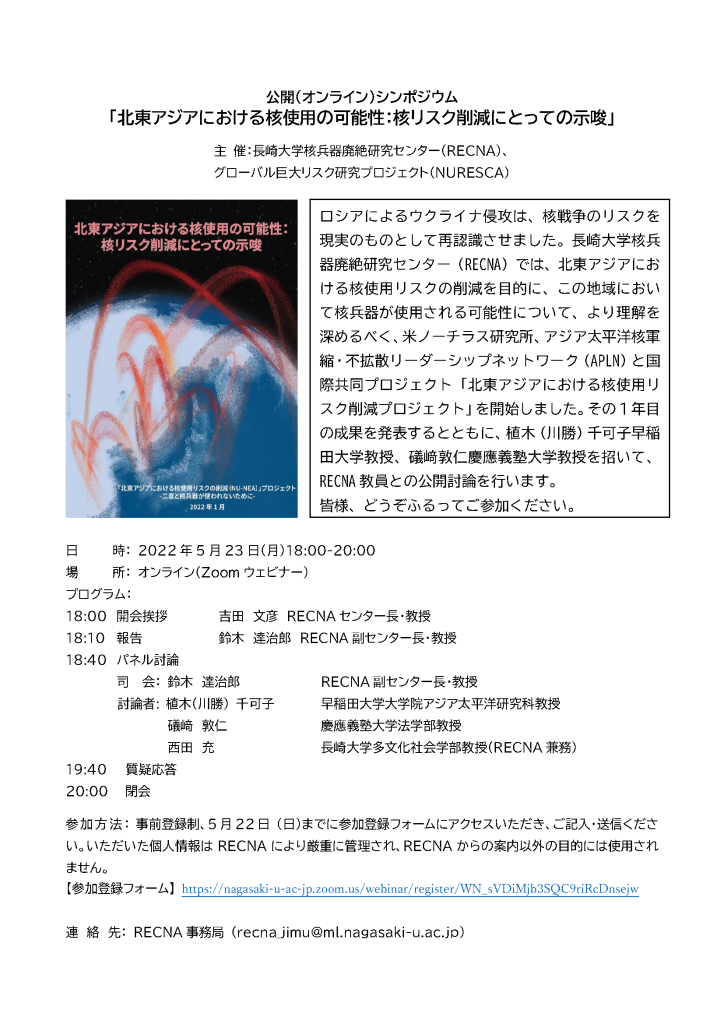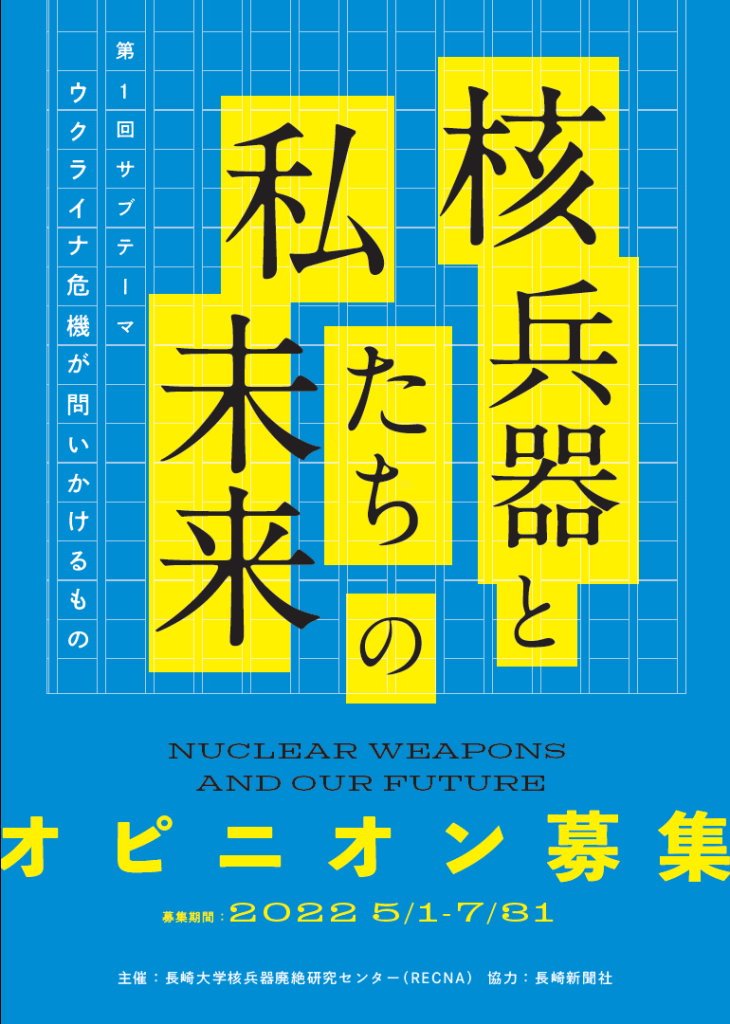新着情報What’s New
長崎大学核兵器廃絶研究センター(RECNA)見解
2022年5月25日
2022年5月21日、23日と続けて韓米首脳共同声明1 、日米首脳共同声明2 が発表された。今回の共同声明は、ウクライナ危機に始まる安全保障及び同盟関係のみならず、経済安全保障、気候変動、パンデミックなど幅広いテーマを含む包括的な共同声明となっている。その中で北東アジアの非核化と安全保障、ならびに核軍縮・不拡散の観点からとくに注目すべき点について、RECNAの見解をまとめた。
1. 朝鮮半島の非核化:信頼醸成と地域全体の新たな安全保障の枠組み提起を
韓米・日米共同声明において、ともに「朝鮮半島の非核化」へのコミットメントが確認された。今後はその進め方が一段と重要な課題となるが、RECNAとしては、シンガポール米朝共同声明3 の精神を引き継いで、朝鮮半島の安定と平和にむけた外交を強めることが肝要と考える。そのためにも中国・ロシアも含め、北東アジア全体での信頼醸成と対話の努力を継続し、新たな安全保障の枠組みを提起していく必要がある。そこでは軍縮・軍備管理の枠組みの構築も不可欠で、安全保障と軍縮・軍備管理は切り離すことのできない、一対の関係にある。また、パンデミック危機を迎えている北朝鮮への人道支援を含め、「対立」を超えた緊張緩和への外交努力が求められる。北朝鮮は、核・ミサイル実験を自制し、対話の道に踏み出すことが最良の選択肢と判断すべきである。
共同声明は北朝鮮・中国・ロシアの脅威に対応すべく「拡大抑止・対処力の強化」を盛り込んだが、そこに偏れば逆に地域の緊張をさらに高めるリスクがある。共同声明が示した指導者レベルのコミュニケーションや対話の必要性を常に認識し、危機回避のための外交戦略の練り直しを強く求める。
2. 核軍縮と核不拡散:「核不使用」の規範強化を
韓米共同声明には含まれていないが、日米共同声明では、「核兵器のない世界」にむけての意思が確認され、核不拡散条約(NPT)の強化や、透明性向上、ウクライナ危機でより現実のものとして認識されるようになった核リスク低減が明記された点は評価できる。しかし、NPT第6条の遵守は含まれなかった。今年8月に開催予定のNPT再検討会議に向けて、「核戦争は戦ってはならない」という2022年1月3日に公表された五大核兵器国の首脳共同声明4 に則り、核保有国に対して「核不使用」の規範強化を改めて訴えておきたい。
3. 「G7サミットの広島開催」:被爆地から核軍縮の新たな潮流を
共同記者会見5 で2023年「G7サミットの広島開催」が公表されたことは被爆地として大いに歓迎すべき決定である。核軍拡の流れをとめ、新たな核軍縮の流れをつくる絶好の機会である。被爆地から、核兵器のもたらす「非人道性」「被爆の実相」を改めて世界に訴え、G7首脳が被爆地で「核兵器のない世界」にむけて新たな決意を示すことが期待される。
1 “US-ROK Leaders’ Joint Statement”, May 21, 2022. https://www.whitehouse.gov/briefing-room/statements-releases/2021/05/21/u-s-rok-leaders-joint-statement/
2 日米首脳共同声明「自由で開かれた国際秩序の強化」、2022年5月23日。 https://www.mofa.go.jp/mofaj/na/na1/us/shin4_000018.html
3 “Joint Statement of President Donald J. Trump of the United States of America and Chairman Kim Jong Un of the Democratic People’s Republic of Korea at the Singapore Summit”, June 12, 2018. https://trumpwhitehouse.archives.gov/briefings-statements/joint-statement-president-donald-j-trump-united-states-america-chairman-kim-jong-un-democratic-peoples-republic-korea-singapore-summit/
4 “Joint Statement of the Leaders of the Five Nuclear-Weapon States on Preventing Nuclear War and Avoiding Arms Race”, January 3, 2022. https://www.whitehouse.gov/briefing-room/statements-releases/2022/01/03/p5-statement-on-preventing-nuclear-war-and-avoiding-arms-races/
「核戦争に勝者はありえず、核戦争は決して戦ってはならない-5核兵器国首脳共同声明の意義と課題」、RECNA Policy Paper(REC-PP-13), 2022年3月。 https://www.recna.nagasaki-u.ac.jp/recna/bd/files/REC-PP-13.pdf
5 「来年のG7サミット、広島で開催へ 日米首脳会談でバイデン氏賛同」、朝日新聞、2022年5月23日。 https://digital.asahi.com/articles/ASQ5R4R2CQ5RUTFK00Y.html
これからの核軍縮:核兵器禁止条約と核不拡散条約(2022年度 第1回 核兵器廃絶市民講座)
講 師: 西田 充 (長崎大学多文化社会学部教授)
中村 桂子 (RECNA准教授)
日 時: 2022年4月30日(土)13:30~15:00 (講座終了後 RECNAと語ろう)
会 場: 長崎原爆資料館ホール+オンライン配信
主 催: 核兵器廃絶長崎連絡協議会(PCU-NC)
共 催: 長崎大学核兵器廃絶研究センター(RECNA)
★ 動画が公開されました。どうぞ、ご覧ください。 ![]() 動画(YouTube)へ
動画(YouTube)へ
【公開シンポジウム】「北東アジアにおける核使用の可能性:核リスク削減にとっての示唆」オンライン開催(5月23日)のお知らせ
※YouTube で動画を公開しました。こちらよりご覧ください。
※発表資料 (PDF) を公開しました。こちらよりご覧ください。
 ロシアによるウクライナ侵攻は、核戦争のリスクを現実のものとして再認識させました。長崎大学核兵器廃絶研究センター(RECNA)では、北東アジアにおける核使用リスクの削減を目的に、この地域において核兵器が使用される可能性について、より理解を深めるべく、米ノーチラス研究所、アジア太平洋核軍縮・不拡散リーダーシップネットワーク(APLN)と国際共同プロジェクト「北東アジアにおける核使用リスク削減プロジェクト」を開始しました。その1年目の成果を発表するとともに、植木(川勝)千可子早稲田大学教授、礒﨑敦仁慶應義塾大学教授を招いて、RECNA教員との公開討論を行います。皆様、どうぞふるってご参加ください。
ロシアによるウクライナ侵攻は、核戦争のリスクを現実のものとして再認識させました。長崎大学核兵器廃絶研究センター(RECNA)では、北東アジアにおける核使用リスクの削減を目的に、この地域において核兵器が使用される可能性について、より理解を深めるべく、米ノーチラス研究所、アジア太平洋核軍縮・不拡散リーダーシップネットワーク(APLN)と国際共同プロジェクト「北東アジアにおける核使用リスク削減プロジェクト」を開始しました。その1年目の成果を発表するとともに、植木(川勝)千可子早稲田大学教授、礒﨑敦仁慶應義塾大学教授を招いて、RECNA教員との公開討論を行います。皆様、どうぞふるってご参加ください。
| 日 時: | 2022年5月23日 (月) 18:00~20:00 |
| 開 催 方 法: | オンライン(Zoomウェビナー) |
| プログラム: |
18:00 開会挨拶 吉田 文彦 RECNAセンター長・教授 18:10 報告【資料】(PDF) 鈴木 達治郎 RECNA副センター長・教授 18:40 パネル討論 司 会:鈴木 達治郎 RECNA副センター長・教授 討論者:植木(川勝)千可子 早稲田大学大学院アジア太平洋研究科教授 礒﨑 敦仁 慶應義塾大学法学部教授 西田 充 長崎大学多文化社会学部教授(RECNA兼務) 19:40 質疑応答 20:00 閉会 |
| 主 催: | 長崎大学核兵器廃絶研究センター(RECNA) 長崎大学多文化社会学部グローバル巨大リスク研究プロジェクト(NURESCA) |
| お問合せ先: | 長崎大学核兵器廃絶研究センター(RECNA) |
【設立10周年記念事業】第1回「核なき未来」オピニオン募集 [ENG]
募集は終了しました。多数のご応募ありがとうございました!
選考結果は9月24日(土)にRECNAウェブサイトで発表します。
16歳以上30歳未満の若者を対象に「核兵器と私たちの未来」に関するオピニオン(小論文、エッセイなど形式は自由)を募集します。2022年のサブテーマは「ウクライナ危機が問いかけるもの」です。あなたの想いや意見を自由に綴ってください。
卓越したオピニオンには賞を与えます。最優秀賞1名は長崎での授賞式:2022年9月24日(土) に招待します。また受賞したオピニオンは長崎新聞に掲載されます。
【応募について】
| ■資 格: |
|---|
| 16歳以上30歳未満(2022年7月31日時点の年齢)。居住地・国籍は問いません。 |
| ■方 法: |
|
下記の書類を PDF形式 で、下記宛先まで一括してE-mailに添付し提出してください。 (1) 応募申請書 1部(様式) (2) オピニオン※ 1部 (※日本語2000文字程度、英語1000ワード程度。オリジナル・未発表に限ります。) |
| ■応募期間: |
| 2022年5月1日~7月31日(必着) |
| ■提 出 先: |
|
opinion@ml.nagasaki-u.ac.jp(厳守) ※提出後1週間しても受領のお知らせが届かない場合は、下記問い合わせ先までご連絡ください。 |
【賞品・副賞】
|
■最優秀賞 1名: 記念盾、副賞賞金5万円、長崎での授賞式に招待(国内受賞者のみ)。希望者には長崎平和ツアーをアレンジします。 ■優 秀 賞 2名: 記念盾、副賞賞金3万円 |
【選考と発表】
| ■選 考: |
|---|
| 審査委員会による厳正なる審査の上、最優秀賞1名、優秀賞2名を選定します。 |
| ■審査委員会: |
|
青来 有一(芥川賞作家、RECNA客員教授)審査委員長 石田 謙二(長崎新聞社取締役編集局長、RECNA客員教授)副委員長 中村 桂子(RECNA准教授)副委員長 小島 萌衣(NHK長崎放送局記者) 鈴木 達治郎(RECNA副センター長、教授) 畠山 澄子(ピースボートスタッフ) 松永 瑠衣子(平和活動家) |
| ■審査基準: |
|
以下の項目で審査を行います。 ①明確であること、②論理に矛盾がないこと、③事実に基づくこと、④独創性があること、⑤表現力があること |
| ■発 表: |
|
RECNAウェブサイトおよび長崎新聞紙上で発表します。 |
| ■授 賞 式: |
|
2022年9月24日(土)13:00~14:00 於:長崎大学 最優秀オピニオンは後日、長崎新聞に全文を掲載します。他の優秀作も含め、すべての受賞作はRECNAウェブサイトに公表します。 |
| ■主 催: 長崎大学核兵器廃絶研究センター(RECNA) |
| ■協 力: 長崎新聞社 |
【問い合わせ】
長崎大学核兵器廃絶研究センター(RECNA)
TEL:095-819-2164
E-mail: recna_staff@ml.nagasaki-u.ac.jp
Website: https://www.recna.nagasaki-u.ac.jp/recna/

















